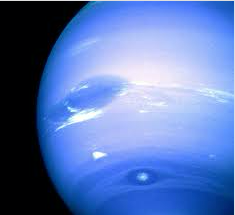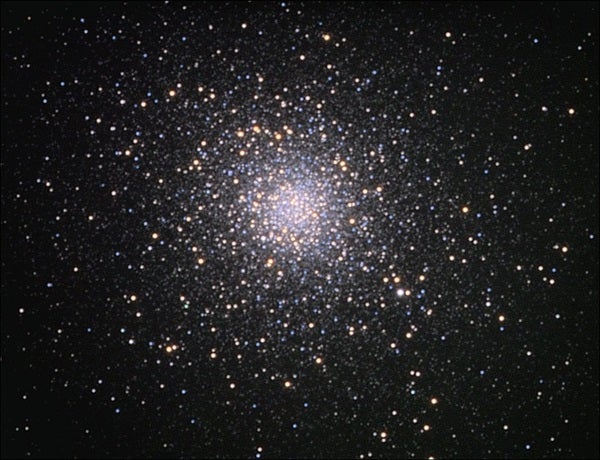Friday, June 16
Neptune’s eastward motion against the background stars comes to a halt at 7 p.m. EDT. This so-called stationary point marks the beginning of the best period to observe an outer planet. Neptune rises around 1 a.m. local daylight time and appears nearly 30° high in the southeast as morning twilight commences. The magnitude 7.9 planet lies in Aquarius, 17′ (about half the Moon’s diameter) east of 6th-magnitude 81 Aquarii. You’ll need binoculars to spy Neptune and a telescope to see its blue-gray disk, which spans 2.3″.
Saturday, June 17
Last Quarter Moon occurs at 7:33 a.m. EDT. The half-lit orb rises slightly after 1 a.m. local daylight time and climbs in the southeastern sky along with the background stars of Aquarius the Water-bearer.
Sunday, June 18
Although asteroid 12 Victoria glows dimly at magnitude 10.8, you shouldn’t have a major problem finding it through a telescope this week. The asteroid lies just 2° northwest of 1st-magnitude Spica, the blue-white luminary of Virgo. This region resides in the southwestern sky after evening twilight fades away. The next three nights are particularly good times to track down Victoria because it slides through a crooked line of stars. If you sketch the field tonight and then return to the same area tomorrow or Tuesday, you should be able to detect the asteroid’s movement relative to the stellar background.
Monday, June 19
Jupiter appears halfway to the zenith in the southwestern sky during twilight this week and doesn’t set until nearly 2 a.m. local daylight time. The brilliant planet shines at magnitude –2.1 and dominates the evening sky. It appears nearly stationary against the background stars of Virgo, some 11° northwest of the Maiden’s brightest star, 1st-magnitude Spica. When viewed through a telescope, Jupiter’s disk spans 39″ and shows a wealth of atmospheric detail. East Coast residents who observe the giant planet early this evening also have the opportunity to see the shadows of its moons Io and Europa on the cloud tops. Io’s shadow appears on the disk as soon as the planet comes out after sunset, while Europa’s shadow joins it at 10:04 p.m. EDT. You’ll see both for the next 34 minutes before Io’s shadow lifts back into space. Europa’s sticks around until 12:28 a.m. EDT.
Tuesday, June 20
Although Venus reached its greatest elongation from the Sun earlier this month, it now rises earlier and climbs higher in the east before dawn. It rises shortly after 3 a.m. local daylight time and stands 17° above the horizon an hour before sunrise. It’s hard to mistake the inner planet for anything else — at magnitude –4.3, it shines brighter than any other point of light in the sky. And this morning, you’ll see it paired with a lovely crescent Moon, which lies about 7° to Venus’ right. (Tomorrow morning, a thinner crescent Moon hangs a similar distance to the planet’s lower left.) When viewed through a telescope, Venus shows a 20″-diameter disk that appears slightly more than half-lit.
Wednesday, June 21
Earth’s summer solstice occurs at 12:24 a.m. EDT (9:24 p.m. PDT on June 20), when the Sun reaches its farthest point north in the sky. This marks the official beginning of summer in the Northern Hemisphere, and the day of the solstice has more hours of sunlight than any other. From mid-northern latitudes, however, the earliest sunrise occurred about a week ago and the latest sunset won’t happen until next week.
Mercury passes behind the Sun from Earth’s perspective at 10 a.m. EDT. This means the innermost planet lies on the opposite side of the Sun from Earth and remains hidden in our star’s glare. It will return to view in the evening sky early next month.
Thursday, June 22
Magnificent Saturn reached its peak just a week ago, when it appeared opposite the Sun in the sky, and our view of the ringed planet remains spectacular. It is on display nearly all night among the background stars of southern Ophiuchus, hanging in the southeastern sky as darkness falls and climbing high in the south by midnight local daylight time. Saturn continues to shine brightly, too, at magnitude 0.0. When viewed through a telescope, the dramatic ring system spans 42″ and tilts 27° to our line of sight, while the planet’s family of moderately bright moons appears next to the gorgeous world.
Friday, June 23
New Moon occurs at 10:31 p.m. EDT. At its New phase, the Moon crosses the sky with the Sun and so remains hidden by our star. Because the Moon also reaches perigee, the closest point in its orbit around Earth, today (at 6:52 a.m. EDT), residents in coastal areas can expect higher than normal tides for the next few days. At perigee, the center of the Moon lies 222,412 miles (357,937 kilometers) from Earth’s center.
Saturday, June 24
The conspicuous Summer Triangle asterism dominates the eastern sky in late evening. Vega, the triangle’s brightest member, shines at magnitude 0.0 and stands highest of the three stars. To its lower left lies Deneb; at magnitude 1.3, it’s the faintest of the trio. Magnitude 0.8 Altair completes the bright asterism. Despite its name, the Summer Triangle appears prominent from late spring until winter begins.
Sunday, June 25
This week offers a good opportunity for binocular users to track down the northern sky’s brightest globular cluster. M5, whose 100,000 stars glow at a combined magnitude of 5.7, lies in the southwestern corner of the constellation Serpens the Serpent. You can locate it just 0.4° north-northwest of the 5th-magnitude star 5 Serpentis. Binoculars show the cluster as a hazy ball of light punctuated by a bright core.












